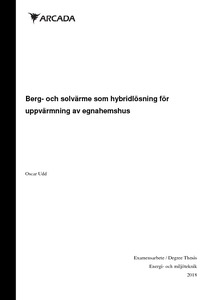Berg- och solvärme som hybridlösning för uppvärmning av egnahemshus
Udd, Oscar (2014)
Udd, Oscar
Yrkeshögskolan Arcada
2014
All rights reserved
Julkaisun pysyvä osoite on
https://urn.fi/URN:NBN:fi:amk-2018060512546
https://urn.fi/URN:NBN:fi:amk-2018060512546
Tiivistelmä
Solvärmesystem baserar sig på att absorbera solstrålning i syfte att överföra dess energi till värme. I bergvärme däremot tar man tillvara den värme som solen överfört till jordmånen för att producera värme. Detta arbete behandlar möjligheterna att använda dessa båda med varandra i ett så kallat hybridsystem, som i arbetet står för fastighetens uppvärmning. Tanken med hybridsystemet är att överloppsenergin som solfångarna producerar på sommaren skall värma upp energibrunnen för att nå en bättre verkningsgrad i bergvärmepumpen. Arbetet baserar sig på litteraturanalys av tidigare forskning, information från tillverkaren av solfångare och bergvärmepump, samt simuleringar på solvärmeproduktion. Som andra källor har jag använt riktpriser från tillverkarn av olika komponenter som behövs i systemet. Syftet med arbetet är att undersöka ifall det är mer ekonomiskt lönsamt och mer miljövänligt att ha ett hyrbridsystem, jämfört med bara ett konvettionellt uppvärmningsystem i fastigheten. I kostnadskalkyldelen jämförs olja, olja med solfångare, bergvärme och bergvärme med solfångare genom beräkningar i Excel. Som slutresultat presenterars resultat för både ekonomisk lönsamhet och miljöpåverkan för de olika systemen. I fråga om ekonomisk lönsamhet visade det sig att bergvärme är mest lönsam på både ett 15 samt 30 års perspektiv. Där ett enhetspris för energin på 30 år blev 0,086 €/kWh. Åtrebetalningstiden för bergvärme blev 10 år, medan hybridsystemets återbetalningstiden blev 14 år, båda jämfört med oljan. Ur ett miljöperspektiv visade sig hybridsystemet vara bäst, där CO2 utsläppen är 48 kg/ CO2 /år ,vilket är 100 gånger mindre än för vad fastigheten hade med endast oljeanvändning. Solar heat systems are based on absorbing solar radiation with the purpose of using the energy as a heat source. In geothermal energy you take advantage of the heat that the sun transfers into the soil and produce energy from it. The purpose of this thesis is to address the possibilities of using these both energy sources in one, so called hybrid system, which in this thesis is the heat source of the property. The idea is that the hybrid systems surplus energy which the solar panels produces during summer would heat the energy well and therefore reach a better efficiency in the geothermal heat pump. The thesis is based on literature analysis of earlier research, information from the manufacturer of solar panels and geothermal pumps and simulations of solar energy production. For other sources I have used target prices of different components that are needed in the system from the manufacturers. The purpose of this thesis is to research the cost/efficiency differences between a hybrid system and a conventional heating system in the property. In the cost calculation oil, oil with solar panels, geothermal energy and geothermal energy with solar panels are compared through calculations in Excel. The end result is presented as a result of economic profitability and environmental impact from the different systems. In the case of economic profitability it showed that geothermal energy is the most cost efficient on both a 15 and 30 year perspective. The unit price of the energy, on a 30 year plan where 0,086 €/kWh. The payback time of the geothermal system was 10 years, while the hybrid systems payback time was 14 years, both compared to oil. From an environmental perspective the hybrid system proved to be the best option, where the CO2 emissions are 48 kg/ CO2/ year, which is 100 times less than what the property had with only oil heating.
